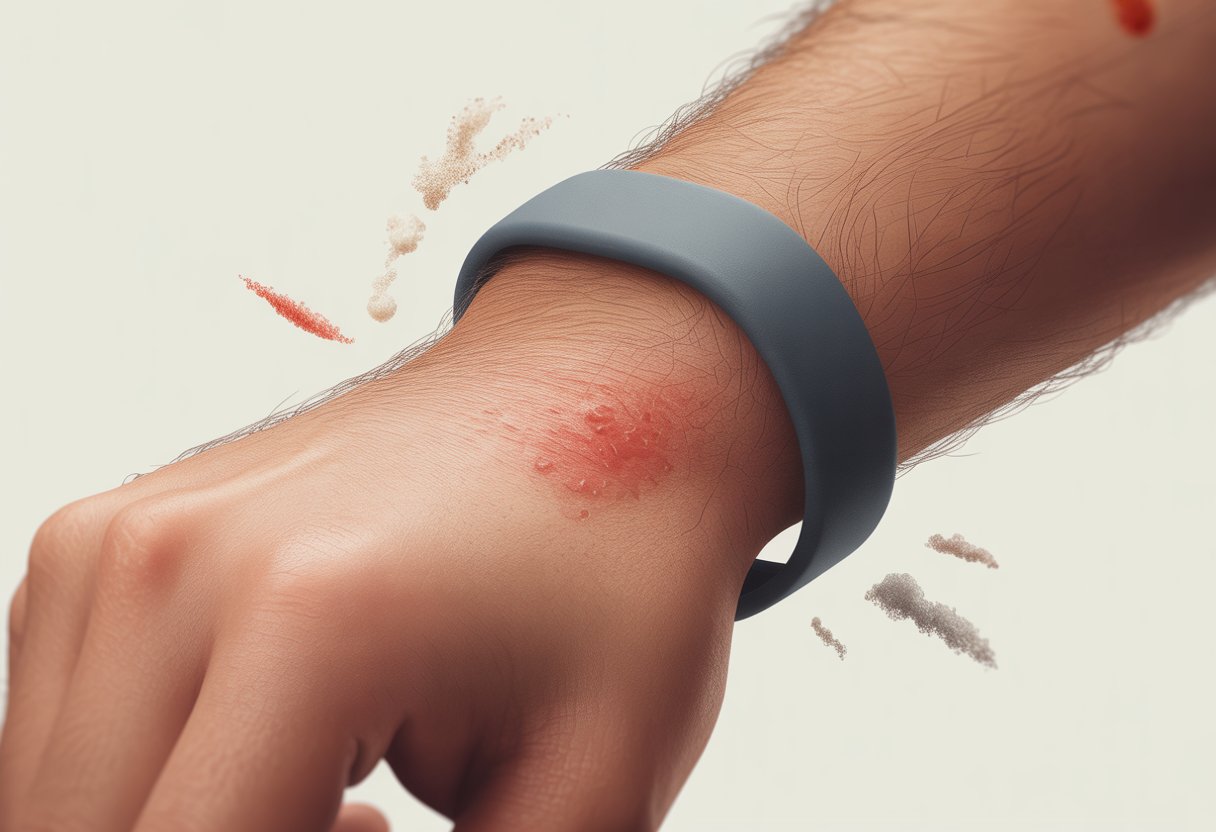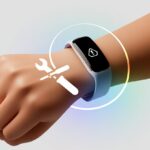Let’s be real: most of us picked up a fitness tracker to nudge ourselves toward better habits, not to start an endless itch fest on our wrists.
Fitness tracker bands can bug our skin thanks to sweat, friction, trapped grime, or just wearing them way too tight. If you’ve ever ended a workout with more scratches than steps, you’re definitely not alone.

We’ve all been there—one minute, we’re counting steps and feeling accomplished, the next we’re scratching at a red patch, wondering if our wrist is plotting revenge.
Most of the time, it’s sweat, detergent, or just plain dirt getting trapped and causing a reaction between our skin and that band.
Before you toss the tracker or swap wrists for the zillionth time, let’s figure out what’s really going on. Our skin deserves a workout partner, not an itch machine.
Common Skin Reactions to Fitness Tracker Bands
A lot of us want to wear our fitness trackers around the clock, but sometimes our skin just isn’t having it.
Redness, bumps, and even painful irritation can pop up after all that close contact.
Contact Dermatitis
Contact dermatitis—yeah, the ultimate party crasher for wearable tech. Our skin might freak out when something touches it, like the band or whatever’s hiding underneath.
Sweat, soap, detergent, or lotion can sneak under the band and stir up trouble. You might see itching, dryness, flaking, or those classic red patches.
The band’s material isn’t always the only villain; lotions and perfumes trapped against our skin can join the fun. Even if you’re super clean, friction can still make your wrist angry.
Curious about irritant contact dermatitis? Here’s a helpful explanation.
To dodge contact dermatitis, we just need to clean the band regularly, wipe off sweat, and give our wrists a breather now and then.
Rashes and Redness
When our skin starts to rebel, the first sign is usually a rash. These rashes show up red, bumpy, and honestly, pretty itchy.
Some bands are sneakily tight, which just ramps up the friction and traps moisture. That combo can turn a happy wrist into a red disaster, especially after sweaty workouts or in hot weather.
The redness usually appears right where the band touches. If we keep wearing the tracker without a break, the rash can stick around or even get worse.
Detergents and soaps stuck under the band can make it even itchier. For tips on avoiding tracker rashes, here’s a quick breakdown.
Loosening the band, switching materials, and giving your wrist a break can help calm things down.
Blisters and Swelling
The worst? Blisters and swelling. Blisters are those tiny fluid bubbles that show up when skin gets too much friction or pressure.
Bands that are too tight are the main culprits—they squeeze and rub, especially when you’re sweaty. Swelling can happen if we ignore the early warnings like redness and itching.
Our wrists might puff up, sting, or just feel extra sensitive. If a blister pops, germs can sneak in and cause an infection.
No one wants to explain to a doctor that their fitness tracker started a wrist war. To avoid all this, keep bands comfy (not tight), skip wearing them overnight if your skin’s already mad, and let your skin chill before putting the tracker back on.
Why Your Fitness Tracker Band Upsets Your Skin
Sometimes, our fitness tracker feels less like a buddy and more like a prankster. Red, itchy skin just won’t quit.
What’s behind all the wrist drama? Let’s dig into the main offenders.
Sweat and Its Mischief
Workouts make us stronger, but wow, do they make us sweat. When sweat hangs out under the tracker band, our skin can’t breathe.
Sweat acts like a tiny troublemaker, breaking down our skin’s natural barrier and making irritation way more likely. Add the friction from the band, and things get uncomfortable fast.
Waterproof bands, especially silicone, can be sneaky. They trap moisture and create a playground for skin irritation.
If we let grime and sweat build up, it just gets worse. That’s why it helps to clean and dry under the band often. Here’s more about how waterproof materials make sweat and moisture harder to escape.
Nickel and Allergy Drama
Nickel—oh, the classic culprit. Tons of fitness trackers have metal parts, and even a little nickel can cause big problems if you’re sensitive.
Nickel allergies show up as itchy, red, or even blistered skin. Sometimes, the spot under the tracker looks sunburned or bumpy.
If you’ve got the allergy, your immune system treats nickel like a monster. Some bands use stainless steel, which usually has less nickel, but it’s not always safe.
Switching to a fabric or silicone band can help stop the allergic reaction nightmare.
Bacteria Buildup
Don’t forget about bacteria. Sweat and grime under the band give bacteria a perfect place to multiply.
If we skip cleaning, these little party crashers can trigger red rashes, bumps, or even peeling, burning skin. To stop the rash rollercoaster, we should scrub our bands regularly and let both the band and our skin dry out after workouts.
More on the role of bacteria and trapped sweat in skin irritation.
Materials: What’s Touching Your Wrist?
Our skin can be picky about what we wrap around our wrists every day. The material of your tracker’s band might be the sneaky culprit behind those red, itchy spots.
Surgical-Grade Stainless Steel vs. Regular Stainless Steel
Let’s be honest—we want our wrists to look good, but not at the cost of a rash. Surgical-grade stainless steel is the hero here, known for being hypoallergenic.
It’s got extra nickel protection, so our skin is less likely to freak out. Regular stainless steel, though? Not so much.
It usually has more nickel, which can be a nightmare if you’re allergic. If your skin gets red or bumpy, it might be time to switch to surgical-grade steel.
Not all “stainless steel” bands are actually the good stuff. Some bands just pretend to be fancy, and your wrist will call them out pretty fast.
Silicone, Plastics, and Other Culprits
Silicone bands sound great—flexible, waterproof, easy to clean. But for some of us, our skin just isn’t a fan.
Moisture, sweat, and dirt love to hang out underneath, making silicone bands a top culprit for irritation.
Plastic bands aren’t much better. They trap heat and don’t let your wrist breathe.
If we forget to clean them (or our skin), we might get more than just fitness stats. Allergic reactions? Yeah, they can happen from dyes, adhesives, or even dust stuck under there.
If your wrist is staging a protest, it might be the material—not just your workout routine.
Famous Brands That Might Be Bugging You
Our wrists should be happy, but some fitness tracker brands just can’t seem to get it right.
Let’s see which familiar names pop up in all those “rash horror stories” online.
Fitbit and Its Many Faces
We all know someone who’s counting steps with a Fitbit, only to end up swapping stories about weird red splotches. Devices like the Fitbit Force and Charge are famous—not just for tracking, but for annoying our skin.
Fitbit bands use materials like silicone and sometimes nickel in the metal bits. Nickel allergies are real, and who wants to be allergic to their own wrist?
Extra sweat, moisture, or a buildup of soap and lotion under the band can make things worse. Wearing it too tight? That’s a big one—users talk about it all the time.
To avoid the dreaded red wrist, keep the band snug but not tight—think gentle hug, not wrist tourniquet. Clean the band and your skin regularly. And if a rash shows up, maybe give your wrist a break.
The Apple of Your Arm’s Eye
Apple Watches look cool and high-tech, but sometimes style comes with a side of skin irritation. Many bands are made of smooth silicone or woven nylon, which can trap sweat and build up moisture.
The result? Itchy, bumpy skin that’s more “mystery rash” than “badge of honor.” Some Apple Watch bands have metal pieces or buckles, so if you’re sensitive to nickel, that’s double trouble.
And honestly, how many of us have worn our smartwatch for days without letting our skin breathe? Guilty.
Tightness and lack of airflow are big culprits, according to experts. If you want to avoid turning your Apple Watch into a fashion fail, try switching bands, keeping everything clean, and loosening the strap now and then.
Sometimes, you just have to remind your Apple Watch who’s boss.
Garmin’s Gripes
Garmin users aren’t immune to wrist drama. Whether we’re training for a marathon or just glancing at our heart rate, Garmin’s silicone and plastic bands can annoy our skin.
Sweat gets trapped under the band, and friction from a shifting tracker doesn’t help. Their devices are designed for all-day wear, but that just gives sweat and grime more time to build up.
We often wear these bands too tight, chasing a snug fit for tracking, but that just leads to sore spots and red lines. Apparently, our wrists need to breathe as much as the rest of us.
We can cut down on Garmin-induced misery by keeping the band clean and dry and letting our skin take a break. Swapping bands or just cleaning with soap and water helps us avoid that dreaded wrist rash.
Want more tips? Check out how to keep your watch band from irritating your skin.
Troubleshooting: What to Do When Your Band Bothers You
Skin irritation from fitness tracker bands is common, and it’s rarely a sign that our wrists suddenly hate technology. Most issues come from simple things we can fix, but sometimes our skin just needs extra care.
Cleanliness Is Next to Comfiness
When did we last clean our fitness tracker? Odds are, it’s dirtier than our gym towel. Sweat, dead skin, and bacteria hide under the band, causing red, itchy surprises.
Let’s grab a soft cloth, some water, and a bit of gentle soap—not the dish stuff. If we can, remove the band from the device and clean both parts. Get into those tiny crevices, but keep electronics dry.
A regular cleaning schedule can save us a lot of grief.
| Cleaning Frequency | Activity Level | Reminder |
|---|---|---|
| Daily | High—sweat sessions | Before bed |
| Weekly | Casual/office wear | Sunday evening |
Dry the band well before putting it back on. If cleaning doesn’t help, try a different material—sometimes our skin just won’t tolerate silicone, no matter how clean it is.
For more on this, see how watch bands and bacteria can cause rashes.
Loosen Up: Adjusting the Fit
Fitness tracker bands shouldn’t double as blood pressure cuffs. If our hand tingles or the skin under the band looks rough, it’s too tight.
We should be able to slip a finger comfortably between our skin and the band. Tight bands trap moisture and cause friction, making things worse.
Loose bands can get annoying too, so we need to find that “just right” fit. After workouts, swimming, or showers, our skin can swell or shrink a bit, so readjusting helps.
Some bands stretch over time, so check and tweak them now and then. If our skin still gets cranky, maybe it’s time to swap bands for a break.
Taking a Break from Your Tracker
Sometimes, our skin needs a breather, even if our step goal nags us for 24/7 tracking. Taking off the tracker—especially at night or during sweaty activities—lets our skin recover.
Try leaving your wrist bare for a few hours or switch wrists each day. There’s no rule saying the tracker must stay glued to one spot.
If we spot redness, swelling, or bumps, leave the tracker off until it fades. If things don’t improve after a day or two, just let the tracker chill on the nightstand.
It won’t judge us (we hope), and our wrists will thank us.
When to Seek Help from a Dermatologist
If we’ve cleaned, loosened, and rested but the rash just keeps spreading—or starts looking scary—we shouldn’t try to play dermatologist.
Oozing, severe redness, swelling, blisters, or lasting pain mean it’s time to call in a pro. Allergies to stuff like nickel in the watch, or the type of plastic or rubber, might be to blame.
If we suspect an allergy, a doctor can help us track down the culprit. More info here: allergies and fitness tracker rashes.
If rashes keep coming back, ask about hypoallergenic bands or barrier creams. There’s nothing wrong with admitting our wrists are sensitive.
Replacement, Refunds, and What to Ask the Manufacturer
Sometimes, a fitness tracker just doesn’t get along with our skin. When that happens, we might want a refund or a fresh band.
Here’s how to handle it without losing your cool—or your device.
Getting a Refund or Replacement
If our wrists look like they’re auditioning for a rash commercial, it’s time to check the return policy. Most brands, like Fitbit and Garmin, tell us to stop using the band if we get irritated and contact them.
Some companies even have special emails for this—Fitbit listed force@fitbit for rash issues on their site. Keep the original packaging, receipts, and photos to prove our case.
We might have to fill out a form or jump through a few online hoops, so having everything ready helps. If our band’s still under warranty, we might score a replacement strap or maybe even a full refund.
Don’t be afraid to ask for what we need—no one wants to walk around with a red mark shaped like last year’s fitness trend.
If we know we’re allergic to nickel or silicone, mentioning that can help our case. Sometimes companies offer a replacement in a different material if we ask.
While waiting for customer service, a piece of tape isn’t a permanent answer, but it beats looking like we’ve lost a fight with a rubber band.
Contacting Customer Service without Losing Your Cool
Now comes the fun part—explaining our itchy problem to a stranger over email or phone. It’s easy to get frustrated, especially with that endless hold music.
We should keep it polite and maybe toss in a little humor. It never hurts.
Key tips for success:
- Be specific: Describe what’s happening, when it started, and how often we wore the band.
- Attach clear photos: If they want proof, send your best irritated-skin selfie.
- Ask questions: Don’t just take the first offer. Is there a hypoallergenic band? Can we get our money back? Any sympathy points?
We can mention what other users have said online or point out that rashes from fitness bands aren’t rare according to skin experts. Sometimes, that gets a faster reply.
Above all: no yelling. The person on the other end didn’t invent plastic.
Preventing Future Skin Irritations with Wearable Tech
Itchy wrists can ruin our day and our style. If our fitness tracker is causing redness or bumps, it’s time to take action.
Trying Hypoallergenic Bands
No one wants to look like they’ve tangled with poison ivy. Most fitness tracker bands use rubber, silicone, or metal, but not all bands are the same.
Some people react to nickel or adhesives in basic bands. If our skin flares up, it’s time to swap bands.
Switching to a hypoallergenic material, like medical-grade silicone, fabric, or titanium, can make a big difference. Brands now offer plenty of “nickel-free” or “hypoallergenic” options, so we’re not stuck with just one boring look.
Sweat and moisture trapped under our band only make things worse, so picking something breathable and easy to wash is key.
Here’s a pro tip: Clean the new band with mild soap and rinse it well before wearing, since leftover chemicals from the factory can irritate skin.
Want to know what to avoid? Nickel, cheap plastics, and anything that makes your skin tingle before you’ve even finished putting it on.
You can find more info on skin-safe materials in this Allure guide on wearable rashes.
Rotating Devices and Giving Your Skin a Break
Even the best band can leave your wrist irritated if you never give it a break. Honestly, it’s tempting to keep your gadget on all day—especially when you’re chasing that step count—but your skin just needs a little room to breathe.
Try picking a regular time every day to take off your tracker. Maybe during your shower, or when you’re just sitting at your desk.
If you swap the tracker to your other wrist every few days, you’ll probably avoid that annoying redness and friction.
Here’s a quick list to jog your memory:
- Take the band off at night or whenever you’re not moving around much.
- Switch wrists once or twice a week.
- Always let your skin dry completely after sweating or showering before you put the device back on.
- Wipe down the band often to get rid of sweat and soap—honestly, soap can be sneaky and just sits there making things worse. If you want more cleaning tips, check out this advice on stopping band irritation.
Let’s just keep our wrists happy and rash-free. No need to ditch your favorite gadget!
- How to connect Bluetooth headphones to a Chromebook Without Summoning Tech Support - December 15, 2025
- Best Fitness Trackers for EMS Workers: Because Your Heart Rate Isn’t the Only Thing Racing - December 15, 2025
- Why do my Bluetooth headphones not skip tracks? Tech tantrums and other musical mysteries - December 14, 2025






